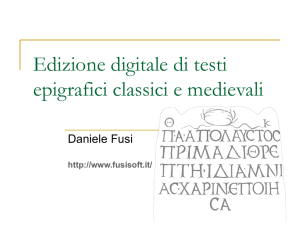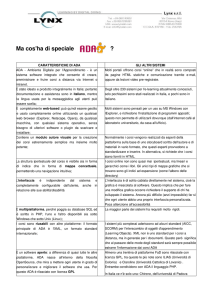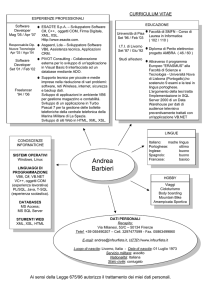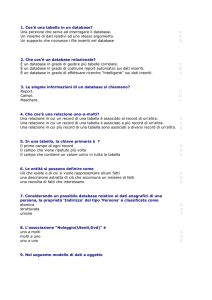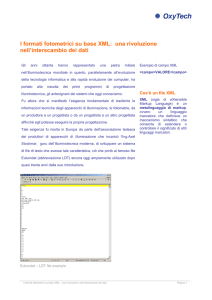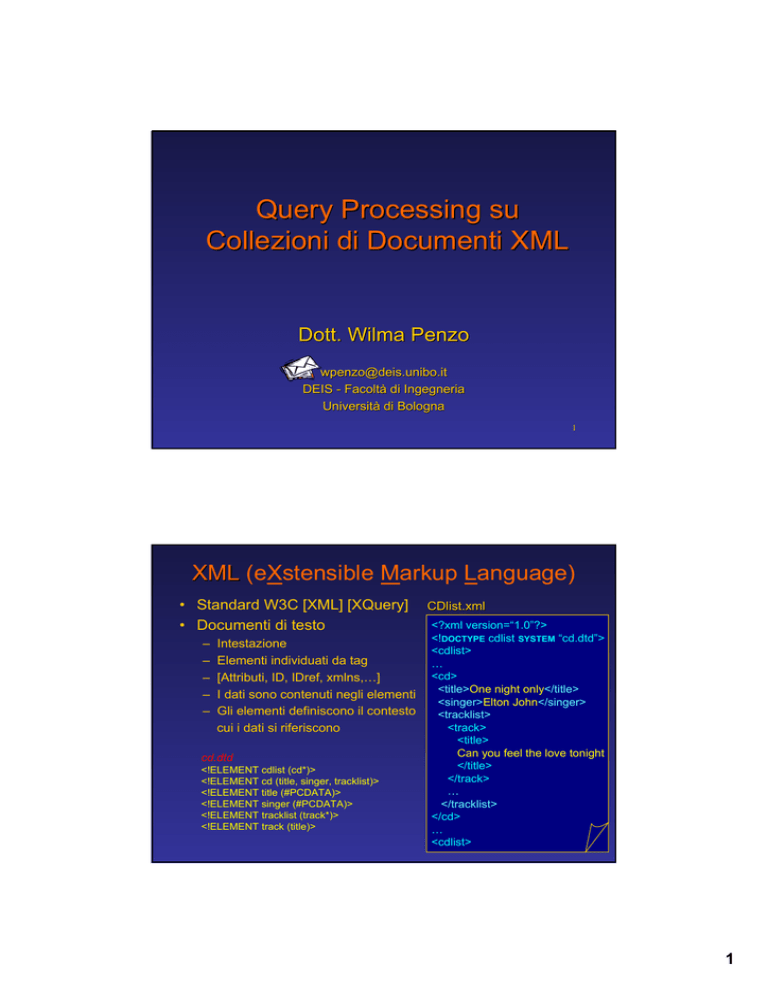
Query Processing su
Collezioni di Documenti XML
Dott. Wilma Penzo
wpenzo@
wpenzo@deis.
deis.unibo.
unibo.it
DEIS - Facoltà di Ingegneria
Università di Bologna
1
XML (eXstensible Markup Language)
• Standard W3C [XML] [XQuery]
• Documenti di testo
–
–
–
–
–
Intestazione
Elementi individuati da tag
[Attributi, ID, IDref, xmlns,…]
I dati sono contenuti negli elementi
Gli elementi definiscono il contesto
cui i dati si riferiscono
cd.dtd
<!ELEMENT cdlist (cd*)>
<!ELEMENT cd (title, singer, tracklist)>
<!ELEMENT title (#PCDATA)>
<!ELEMENT singer (#PCDATA)>
<!ELEMENT tracklist (track*)>
<!ELEMENT track (title)>
CDlist.
CDlist.xml
<?xml version=“1.0”?>
<!DOCTYPE cdlist SYSTEM “cd.dtd”>
<cdlist>
…
<cd>
<title>One night only</title>
<singer>Elton John</singer>
<tracklist>
<track>
<title>
Can you feel the love tonight
</title>
</track>
…
</tracklist>
</cd>
…
2
<cdlist>
1
Perché database XML
• Vantaggi
– Semantica
– Supporto all’eterogeneità dei dati
– Formato semplice e flessibile
• Trasmissione, interscambi fra applicazioni
• Separazione dati da presentazione/logica applicativa
• Ambiti
– Ovunque sia richiesta una gestione di dati non
strutturati
• Digital libraries, E-business, mobile database, Web content,
sistemi CRM, sistemi supply chain
3
In cosa un RDBMS è carente
• Indipendenza dallo schema
• Query capability per dati semi-strutturati
• Supporto built-in per contenuti di tipo non numerico
– Stemmer
– Dizionari
– Ontologie di dominio
• Molti sistemi forniscono solo un interfacciamento a XML
• Nascono i primi database XML nativi (Tamino [XDBMS])
• I vendor più noti (Oracle [XMLDB], IBM [XMLExt],
Microsoft [XSQL]) forniscono un supporto integrato e
completo
Sono in atto molti investimenti
4
2
Retrieval di documenti XML
• Query language standard: XQuery 1.0
– Selettori:
•
•
•
•
•
path expression
wildcard
posizione di elementi in sequenza
predicati aritmetici e di confronto (Booleano!)
formule di predicati combinati con connettivi logici (and, or)
Esempi:
1) CD di Elton John venduti in negozi di New York
cdstore/cd[artist=“Elton John” and ../address//*=”New York”]
2) titolo della seconda canzone del CD di Elton John
intitolato “One night only”
cd/song[2]/stitle[../../title=“One night only”] oppure
cd[title=“One night only”]/song[2]/stitle
5
Storage di documenti XML
• File XML
–
–
–
–
–
–
su file system, in BLOB o CLOB in DB relazionali
Adatto per file XML document-centric (narrativi)
Il contenuto non può essere usato per il retrieval
Creazione di indici a parte
Retrieval del documento intero
Query di aggregazione inefficienti
<chapter>1
book
author
…
Harold
title
content
…
XML….
<title>
XML Concepts
</title>
<content>
XML is a W3C standard
for document markup
…
</content>
</chapter>
…
6
3
Storage di documenti XML
• Tabelle relazionali
– Estrazione dei dati
– Adatto per file XML data-centric con struttura
regolare
– Il documento originale viene perso
– Inefficienza nella ricostruzione del documento XML
<person>
<firstname>
Wilma
</firstname>
<lastname>
Penzo
</lastname>
…
</person>
Parser
(DOM/SAX)
DB
person
firstname lastname …
…
…
…
Wilma
Penzo
…
7
Database XML Nativi
• Unità di memorizzazione: documento XML
• Linguaggio di interrogazione: XQuery
• Update: Manipolazione DOM
• Esempio: TAMINO XML Server
– Full-Text Retrieval
– query execution engine implementa un’algebra di
operatori su alberi (basata su ricorsione)
– structure-index + value-index
8
4
DB2 XML Extender
•
•
•
•
Incluso dalla versione 7.1
documenti XML da dati DB2
repository di DTD
compatibile con il Text Extender (per la ricerca di testo)
•
due modalità di memorizzazione:
1) XML column (3 UDT):
9
9
9
XMLCLOB (Character Large Object)
XMLVARCHAR (tipicamente un URL)
XMLFile (riferimento a file su file system locale)
2) XML collection
9
•
Data Access Definition (DAD):
–
–
•
•
insieme di tabelle relazionali contenenti dati dei documenti XML
quali elementi/attributi indicizzare (1)
mapping da DTD a tabelle e colonne (2)
UDF per insert, select e update di parti o interi documenti (1)
Stored procedure per store, retrieve, update, search e delete (2)
9
DB2 XML Extender
TABLE sales_tab
invoice_number CHAR(6) NOT NULL
PRIMARY KEY
sales_person
VARCHAR(20)
order
XMLVARCHAR
Esempio: Trova i nomi dei commerciali che hanno ricevuto ordini da IBM
con numero dell’invoice superiore a 100
Select sales_person
From sales_tab
Where extractVarChar(order,’/order/customer’) LIKE “%IBM%”
And invoice_number > 100
La UDF extractVarChar esamina il documento XML contenuto in order alla
ricerca della stringa IBM secondo il path /order/customer
Alternativa: Text-Extender per la colonna XML per usare il Text Indexing
(UDF interna db2tx.contains)
10
5
DB2 XML Extender
•
Per XML collection:
–
–
•
Ricerca diretta sulle tabelle SQL
Stored procedures dxxRetrieveXML() e dxxGenXML() per
interrogare e generare documenti XML
DAD:
–
–
Specifica se effettuare il retrieval di porzioni o interi documenti
Inserimenti condizionati al valore di elementi e attributi XML
11
Oracle XML DB
•
XMLType nativo consente alternative di storage:
–
–
•
CLOB
Structured XML
Schema-aware: mapping XML-to-relational database
dbms_xmlschema.registerSchema(‘http://127.0.0.1:8080
/home/Scott/xsd/purchaseOrder.xsd’,’purchaseOrder.xsd’)
–
–
–
•
I documenti XML vengono effettivamente decomposti in
tabelle relazionali secondo lo schema indicato
Dal punto di vista utente rimangono documenti XML
Metafora gerarchica (XML DB Foldering Module)
Hierarchical Index trasparente all’utente
–
Speed up per navigazione di folder e path
12
6
Oracle XML DB
13
Oracle XML DB
•
•
•
Supporta XML Schema (vincoli di ordine, cardinalità,
integrità referenziale)
DOM Fidelity (info su ordine e namespace)
Storage
–
–
–
Eliminazione di tag e spazi
Ricostruzione dinamica tramite XML Schema
XML Object (XOB) vs. DOM
•
•
•
Versione DOM “light”
Lazily-Loaded Virtual DOM
Query
Select value(x)
From purchaseorder x
Where existsNode(value(x),’/PurchaseOrder[User=“Smith”]’)=1
–
Implementa alcune funzioni del (futuro) standard SQL/XML
(IBM, Microsoft, Oracle, Sybase sono alcuni vendors coinvolti)
14
7
La Ricerca su XML
•
Strettamente legata a tematiche database:
–
–
–
–
–
–
–
Storage
Query Processing
Indexing
Data Integration
Publishing
Benchmarking
…
15
Interrogazioni su documenti XML
Query q
cd
address
cd
title
Documento d
cdstore
“Artist Shop”
street
city
title
singer
tracklist
singer
track
“105 Broad St.” “New York” “One night..” “Elton J.”
“night”
“Elton John”
• XPath 2.0 (e XQuery 1.0)
title
“Can you feel…”
– Path expression, wildcard, posizione in sequenza,…
CD di Elton John venduti in negozi dello stato di New York
/cdstore/cd[singer=“Elton John” and ../address//*=”New York”]
CD di Elton John contenenti nel titolo il termine “night”
//cd[singer=“Elton John” and title=”night”]
16
8
Tree Matching
cdstore
“Artist Shop”
Query q
street
title
cd
address
cd
Documento d
city
title
singer
tracklist
singer
track
“105 Broad St.” “New York” “One night..” “Elton J.”
title
“Elton John”
“night”
“Can you feel…”
Q set di nodi query, D set di nodi dati
f: Q → D, ∀ qi,qj ∈Q:
1) f(qi)=f(qj) ⇔ qi = qj
2) label(qi)=label(f(qi))
3) parent(qi,qj) ⇔ parent(f(qi),f(qj))
17
Tree Embedding
cdstore
“Artist Shop”
Query q
track
cd
address
cd
street
Documento d
city
title
singer
?
tracklist
singer
track
“105 Broad St.” “New York” “One night..” “Elton J.”
title
“Elton John”
“love”
title
“Can you feel…”
f: Q → D, ∀ qi,qj ∈Q:
1) f(qi)=f(qj) ⇔ qi = qj
2) label(qi)=label(f(qi))
3) parent(qi,qj) ⇔ ancestor(f(qi),f(qj))
18
9
Limiti di XQuery
• … e di molti altri linguaggi (XML-GL, XML-QL, Lorel,…)
• presuppone conoscenza sull’organizzazione dei dati
(DTD)
• cattura solo soluzioni con match esatto sul contenuto e
sul nome degli elementi/attributi
Rilassamento di vincoli:
• introduzione di predicati di similarità
• approssimazioni sulla struttura
• ranking dei risultati per rilevanza
19
Perché interrogazioni approssimate
• Assenza di conoscenza dello schema dei dati
• Rappresentazione non univoca di relazioni M:N
cd
title
singer
cd
singer
name
title
“One night..”
“Elton J.”
name
“Elton J.”
“One night..”
• Eterogeneità di relazioni strutturali per gli
elementi di uno stesso documento/collezione
• [ACS02] [FG00] [SN00] [TW00]
20
10
Tipi di approssimazioni
Query:
Trova i CD contenenti brani
con “love” nel titolo
Goal: ricerca del pattern
<cd>
<song>
<title> love </title>
</song>
</cd>
Doc1.xml
<cd>
<title>One night only</title>
<singer>Elton John</singer>
<tracklist>
<track>
<title>
Can you feel the love tonight
</title>
</track>
…
</tracklist>
</cd>
21
Tipi di approssimazioni
Query:
Trova i CD contenenti brani
con “love” nel titolo
Goal: ricerca del pattern
<cd>
<song>
<title> love </title>
</song>
</cd>
Doc1.xml è rilevante, anche
se approssimato:
• track è simile a “song”
(semantic relaxation)
• tracklist può essere trascurato
(structural relaxation)
Doc1.xml
<cd>
<title>One night only</title>
<singer>Elton John</singer>
<tracklist>
<track>
<title>
Can you feel the love tonight
</title>
</track>
…
</tracklist>
</cd>
22
11
XXL [Theobald & Weikum 2000]
• Introduce predicati di similarità semantica
Esempio: Trova i brani dei CD di Elton John in cui suonano
sassofonisti
Select T
• Ranking
From http://my.cdcollection.edu/CDstores.xml
Where #.cd As C
And C.#.(~artist) As A
And A = “Elton John”
And C.#.(~track)? As T
And T. ~musician As M
And M.# ~ “saxophone”
– I predicati Booleani hanno valore 0 o 1 a seconda del valore di verità
– score di similarità inteso come probabilità di rilevanza
– combinazione degli score assumendo indipendenza fra le condizioni:
• AND algebrico per path expression e congiunzioni (π1* π2)
• OR algebrico per disgiunzioni (π1 + π2 - π1* π2)
– le wildcard assumono valore 1
23
XIRQL [Fuhr & Großjohann 2001]
<cdstore>Artist Shop
<address street=“105 Broad St.”,
city=“New York”></>
<cd>
<title>One night only</title>
<artist>Elton John</artist>
<tracklist>
<song>
<stitle>
Can you feel …
</stitle>
</song>
</tracklist>
</cd>
</cdstore>
Albero partizionato in index object
1
cdstore
“Artist Shop”
2
address
street
city
title
cd
artist
tracklist
3
song
“105 Broad St.” “New York” “One night..” “Elton J.”
title
Pesatura dei termini localmente agli
Index object
“Can you feel…”
24
12
XIRQL [Fuhr & Groß
Gro johann 2001]
cdstore
1
“Artist Shop”
2
address
street
city
title
cd
tracklist
artist
3
song
“105 Broad St.” “New York” “One night..” “Elton J.”
title
Esempio di query:
“Can you feel…”
//cd[./artist = “Elton John” $and$ .//song/title $cw$ “love”]
Ranking: combinazione Booleana di eventi probabilistici indipendenti
[2,”Elton John”] ∧[3,”love”] score calcolato come: W1,2 * W2,3
con Wi,j peso del termine della condizione i nell’index object j
se “love” fosse presente anche in 1: [2,”Elton John”] ∧ ([1,”love”] ∨ [3,”love”])
Possibile pesatura delle condizioni: //cd[0.6*cond1 $and$ 0.4*cond2]
25
Approximate Tree Embedding
cdstore
“Artist Shop”
Query q
track
title
street
city
title
singer
tracklist
artist
track
lastname
“love”
cd
address
cd
Documento d
“105 Broad St.” “New York” “One night..” “Elton J.”
“John”
title
“Can you feel…”
e: Q → D, ∀ qi,qj ∈ dom(e):
1) e(qi)=e(qj) ⇔ qi = qj
2) sim(label(qi),label(e(qi)))>0
3) parent(qi,qj) ⇔ ancestor(e(qi),e(qj))
26
13
Ranking: ApproXQL [Sch01]
cd
artist
cd
track
lastname
artist
title
“John”
cd
track
singer
title
“John”
“love”
delete
lastname
rename
artist
insert
tracklist
cd
cd
address
street
track
“John”
“love”
cdstore
“Artist Shop”
tracklist
track
“John”
title
“love”
singer
tracklist
singer
title
“John”
“love”
cd
track
city
title
tracklist
singer
track
“105 Broad St.” “New York” “One night..” “Elton J.”
title
title
“love”
Se ogni trasformazione costa 1
Costo totale = 3
q1
“Can you feel…”
Ranking di similarità sul costo
27
minor costo
maggior similarità
Ranking
cd
q2
cdstore
address
author
lastname
“John”
song
Score assoluto
e.g. ApproXQL:
numero di trasformazioni
title
cd
city
“New York”
“love”
author
lastname
song
title
“John”
“love”
Il costo è 3 in entrambi i casi
cd
artist
cdstore
tracklist
lastname
address
song
“John”
cdstore
“Artist Shop”
title
city
cd
address
cd
artist
“love”
street
city
title
artist
“105 Broad St.” “New York” “One night..”
modificati
3 nodi su 7
tracklist
lastname
“New York”
tracklist
“John”
song
title
“love”
song
“Elton J.”
title
“Can you feel…”
modificati
3 nodi su 11
14
SATES [Ciaccia & Penzo 2002]
cd
song
lastname
cd
address
title
author
cdstore
“Artist Shop”
street
city
title
artist
“love”
“105 Broad St.” “New York” “One night..”
?
tracklist
song
“Elton J.”
title
“John”
Approximate Tree Embedding
“Can you feel…”
Q set di nodi query, D set di nodi dati, e: Q → D, ∀ qi,qj ∈dom(e):
1) sim(label(qi),label(e(qi))) > 0
2) parent(qi, qj) ⇒ (ancestor(e(qi),e(qj)) ∨ sibling(e(qi),e(qj)))
3) sibling(qi,qj) ⇒ (sibling(e(qi),e(qj)) ∨ ancestor(e(qi),e(qj)))
Penalizzazione strutturale per il ranking
29
SATES [Ciaccia & Penzo 2002]
cd
cd_vendor
song
author
lastname
“New York”
author
lastname
“John”
q1
“John”
cd
address
song
street
title
“love”
cdstore
“Artist Shop”
cd
city
title
“love”
tracklist
artist
title
“105 Broad St.” “New York” “One night..”
song
“Elton J.”
q2
title
“Can you feel…”
Ranking:
misura di correttezza e completezza semantica e strutturale
misura di coesione dei risultati
sem(q1) > sem(q2)
sem(q1) < sem(q2)
str(q1) = str(q2)
str(q1) < str(q2)
coes(q1) > coes(q2)
[cd_vendor ~ cdstore]
[6/7 matching nodes vs. 8/9 matching nodes]
[1 penalità: song/author vs. cd/artist]
[9/15 (=0.6) vs. 16/23 (=0.69…) matching arcs]
[6/7 (=0.85…) vs. 8/11 (=0.72…) relevant data nodes]
30
15
La Ricerca su XML
•
Strettamente legata a tematiche database:
–
–
–
–
–
–
–
Storage
Query Processing
Indexing
Data Integration
Publishing
Benchmarking
…
31
Index-based XXL SE [Theobald & Weikum 2002]
• Ispirato a Web search engine
– Indici costruiti e aggiornati da crawler
• 3 tipi di indice
Inverted List
(elemento,<[URL1,oid1,parent1,children1],
– Element Path Index (EPI)
…>)
– Element Content Index (ECI)
Tabelle Oracle
– Ontology Index (OI)
InterMedia (Oracle text retrieval engine)
}
XXL servlet
XXL applet
Query
Proc.
Crawler
EPI
Handler
EPI
Path
Indexer
ECI
Handler
ECI
Content
Indexer
Ontology
Handler
OI
Ontology
Indexer
WWW
WWW
L’approssimazione strutturale richiede wildcard esplicite nella query
32
Navigazione di tutti i collegamenti!!!
16
Index Fabric [Cooper et al. 2001]
• Codifica dei path in stringhe
• Indice ottimizzato per la ricerca di stringhe (Patricia Trie)
legenda
doc2
I B N ABC Corp
I B A 1 Industrial Way
I S N Acme Inc
I S A 2 Acme Rd.
I T drill
I T C’ 2
I B N Oracle Inc
I B P 555-1212
I S N IBM Corp
I T N nail
ITC4
I
T
S
B
...
doc1
A
IBA
1 Industrial Way: doc1
N
P
A
N
A
A
ISN
IBM Corp: doc2
ISA
2 Acme Rd.: doc1
IBN
Oracle Inc: doc2
Non c’è
approssimazione
I
O
IBN
ABC Corp: doc1
I = <invoice>
B = <buyer>
N = <name>
A = <address>
S = <seller>
T = <item>
P = <phone>
C = <count>
C’ = count (attribute)
ISN
Acme Inc: doc1
IBP
555-1212: doc2
ToX [Barbosa et al. 2001]
• The Toronto XML Engine
document manager
catalog manager
query processor
Document Access Engine
relational
storage
engine
object
storage
engine
file system
storage
engine
virtual
document
engine
• Storage e indexing eterogenei sulla base della
structuredness dei documenti
• DB2 (future work: altri RDBMS via ODBC)
• Ozone: storage engine per oggetti Java
34
17
ToXin (ToX indexing)
1
publications
2
issue
3
title
5
article
“i-title1”
title
6
13
14
“a-title1”
title
15
“author1” “a-title2”
author
16
publications
IT1
3
4
issue
17
“i-title1”
“i-title2”
IT2
title
VT1
VT3
nodo
year
VT2
article
IT3
title
VT3
author
VT4
valore
6
7
“a-title1”
“a-title2”
10
11
“a-title3”
“a-title4”
“a-title3”
VT4
nodo
6
7
7
10
11
11
VT2
nodo
3
4
Value index
Path index
author
18
“author3”
year
“1991”
11
title
19
“author4”
12
article
10
“i-title2”
title
author
valore
article
9
“1990”
“author2”
VT1
nodo
4
title
8
article
7
author
issue
year
author
author
22
21
20
“author6”
“a-title4” “author5”
valore
“author1”
“author2”
“author3”
“author4”
“author5”
“author6”
IT1
padre
1
IT2
padre
figlio
2
figlio
2
2
3
4
valore
padre
figlio
“1990”
“1991”
3
6
7
10
11
instance
function
IT3
3
4
4
35
ApproXQL Index [Schlieder 2002]
cdstore
1:16
“Artist Shop”
2
address
3:7
street
4:5
8:16
city
6:7
title
9:10
cd
artist
11:12
tracklist
13:16
song
5
7
10
12
14:16
“105 Broad St.” “New York” “One night..” “Elton J.”
title
Artist shop : 2
105 Broad St. : 5
New York : 7
One night...: 10
Elton John: 12
Can you feel: 5
Index Itext
cdstore : 1
address : 3
street: 4
city: 6
cd: 8
title: 9,15
artist: 11
tracklist: 13
song: 14
Index Istruct
15:16
16
“Can you feel…”
Albero “decorato”:
• Numerazione: (preorder # : max id delle foglie sottese)
• costi di inserimento nodo e inserimento path (omessi in figura…)
Operazioni su liste (con calcolo del costo di approssimazione)
• Navigazione bottom-up dell’albero query
• accesso all’indice Itext per reperire i nodi rilevanti per le foglie query
• accesso all’indice Istruct per reperire i nodi intermedi
36
• check di ancestorship sfruttando la numerazione
18
Collection Index [Ciaccia & Penzo 2003]
b
doc1
a
t
c
t
1
a
c
s
t
4
5
a
t
index
b
c
t
s
7
2
3
b
doc2
8
9
a
s
t
13
10
11
6
12
[1,7] [8,13]
c
[3,4] [5,7] [11,13]
t
s
{7,13}
{1,8,9} {2,10}
b = book, a = author, t = title, c = chapter, s = section
{3,5,11} {4,6,12}
L’indice individua lo schema della struttura dei dati
• Ogni path individua una classe di equivalenza di path dati
• Ogni nodo interno mantiene:
• i riferimenti ai discendenti
• una lista di range
• Ogni nodo foglia referenzia un value-index
Creazione:
• Numerazione delle foglie dati
• Inserimento dei path dei documenti senza ripetizioni
37
Query Processing
index
query
b
a
t
{1,8,9} {2,10}
[1,7] [8,13]
c
[3,4] [5,7] [11,13]
t
s
a
b
Data Stream path
Relevant data
ds1: /book/author
{1}
ds2: /book/title
{10}
ds3: /book/chapter/title {3,5,11}
t
“Spencer” “XML”
{7,13}
Risultato 1: {1,3,5}
{3,5,11} {4,6,12}
1)
2)
Esplorazione top-down alla ricerca
dei match dei nodi query
9 Navigazione diretta sui discendenti
9 Contestualizzazione a ogni match
Costruzione risultati bottom-up
9 Set di data stream per ogni
path query
9 Test di inclusione fra range
Risultato 2: {10,11}
<book>
<title>
XML
</title>
<chapter>
<title>
XML for DigLib
</title>
</chapter>
</book>
<book>
<author>
Spencer
</author>
<chapter>
<title>
XML basics
</title>
</chapter>
<chapter>
<title>
XML tools
</title>
</chapter>
</book>
38
19
Collection Index
•
Supporto efficiente per query approssimate
complesse
– Rappresentazione “intensionale”
•
•
•
Template esteso della struttura dei dati
Non è vincolato alla presenza di un DTD
Lo schema viene determinato dai dati stessi
– La ricerca dell’embedding avviene solo sul template
dei dati
– I risultati sono ranked secondo la misura SATES
– Flessibilità nelle strategie di ricerca
– Consente l’indicizzazione di collezioni eterogenee
39
XML Benchmark
•
Framework per analisi di:
–
–
•
•
funzionalità di interrogazione
performance
dei sistemi di gestione di dati XML
Esempi: Xmark, XMach-1, X007
Index Collection su XMach:
–
–
Documenti con struttura eterogenea, profondità fino a 12 livelli,
ripetizione di label su singolo path, ripetizione di path
Data generator (documenti)
9 SW Java
9 Genera documenti conformi a un dato DTD
9 Testo generato sinteticamente da una lista di 10000 termini
inglesi, 2000 nomi e 8000 cognomi per gli autori
–
Test da 1000 a 150000 documenti (20 Mb - 2.3 Gb)
40
20
Bibliografia
[ACS02] S. Amer-Yahia, S. Cho, D. Srivastava. Tree Pattern Relaxation. Proc.
8th Int. Conf. On Extending Database Technology (EDBT), 2002.
[BBM+01] D. Barbosa, A. Barta, A. Mendelzon, G. Mihaila, F. Rizzolo, P.
Rodriguez-Gianolli. ToX – The Toronto XML Engine. Proc. Int. Workshop
on Information Integration on the Web, 2001.
[BR01] T. Böhme, E. Rahm. XMach-1: A Benchmark for XML Data
Management. Proc. BTW 2001.
[CP02] P. Ciaccia, W. Penzo. Adding Flexibility to Structure Similarity Queries
on XML Data. 5th Int. Conf. On Flexible Query Answering Systems, 2002.
[CP02a] P. Ciaccia, W. Penzo. Relevance Ranking Tuning for Similarity
Queries on XML Data. 1st VLDB Work. EEXTT 2002.
[CP03] P. Ciaccia, W. Penzo. The Collection Index to Support Complex
Approximate Queries on XML Documents, 1st Int. VLDB XML and
Database Symposium (XSym03) 2003.
[CSF+01] B. Cooper et al. A Fast Index for Semistructured Data. VLDB 2001.
[FG01] N. Fuhr, K. Großjohann. XIRQL: A Query Language for Information
Retrieval in XML Documents. Proc. of 24th Int, ACM SIGIR Conf. on
Research and Development in Information Retrieval, 2001
[GW97] R. Goldman, J. Widom. DataGuides: Enabling Query Formulation and
Optimization in Semistructured Databases. VLDB 1997.
41
Bibliografia
[Kil92] P. Kilpeläinen. Tree Matching Problems with Application to Structured
Text Databases. PhD. Thesis, Dept. of Comp. Sci., Univ. of Helsinki, 1992.
[LM01] Q. Li, B. Moon. Indexing and Querying XML Data for Regular Path
Expressions. VLDB 2001.
[MS99] T. Milo, D. Suciu. Index Structures for Path Expressions. Proc. 7th Int.
Conf. on Database Theory (ICDT), 1999.
[Pen02] W. Penzo. Integration of Semantic and Structure Similarity for XML
Data Ranking. SEBD 2002.
[RM01] F. Rizzolo, A. Mendelzon. Indexing XML Data with ToXin. Proc. 4th Int.
Work. on the Web and Databases (WebDB) 2001.
[Sch02] T. Schlieder. Schema-Driven Evaluation of Approximate Tree-Pattern
Queries. EDBT 2002.
[SN00] T. Schlieder, F. Naumann. Approximate Tree Embedding for Querying
XML Data. Proc. ACM SIGIR Work. on XML and Inform. Retrieval, 2000
[TW00] A. Theobald, G. Weikum. Adding Relevance to XML. 3rd Int.
Workshop on the Web and Databases (WebDB 2000)
[TW02] A. Theobald, G. Weikum. The Index-Based XXL Search Engine for
Querying XML Data with Relevance Ranking. EDBT 2002.
42
21
Bibliografia
[XDBMS] Tamino XML Server. http://www.softwareag.com/tamino/
[XML] Extensible Markup Language (XML) 1.0. W3C Recommendation, (2nd
ed.), 2000, http://www.w3.org/TR/REC-xml
[XMLExt] IBM DB2 XML Extender.
http://www-3.ibm.com/software/data/db2/extenders/xmlext/xmlextbroch.pdf
[XMLDB] Oracle XML DB. http://otn.oracle.com/tech/xml/xmldb/content.html
[XSQL] MicroSoft SQLServer, XML Web Services.
http://www.microsoft.com/sql/techinfo/xml
[XQuery] XQuery 1.0: A Query Language for XML. W3C Working draft, apr.
2002, http://www.w3.org/TR/xquery
The Apache XML Project. http://xml.apache.org
Ozone: The Open Source Java ODBMS. http://www.ozone-db.org
Xmark – The XML Benchmark Project. http://www.xml-benchmark.org
XMach-1: A Benchmark for XML Data Management.
http://www.dbs.uni-leipzig.de/en/projekte/XML/XmlBenchmarking.html
The X007 Benchmark. http://www.comp.nus.edu.sg/~ebh/X007.html
43
22

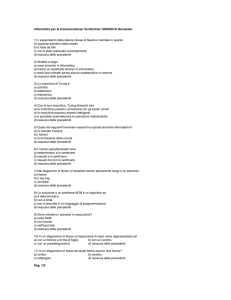
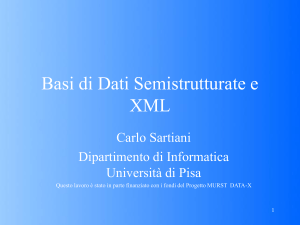
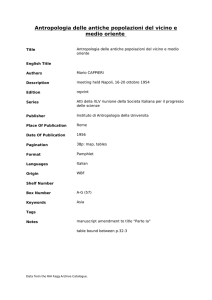
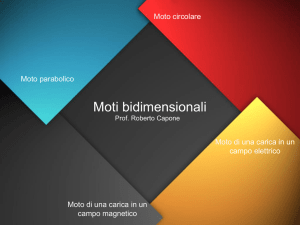

![[WebService] public class HW](http://s1.studylibit.com/store/data/001750837_1-0361cb48ee7260e270082c79bbe594bf-300x300.png)
